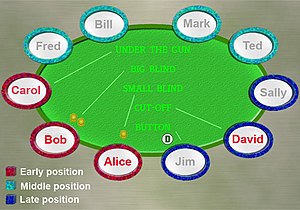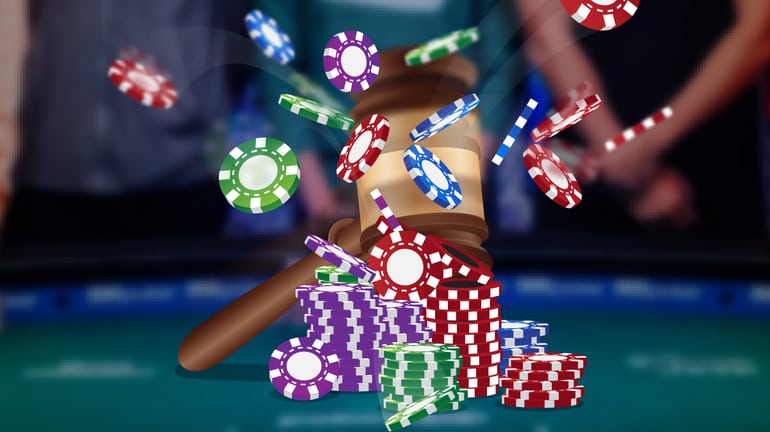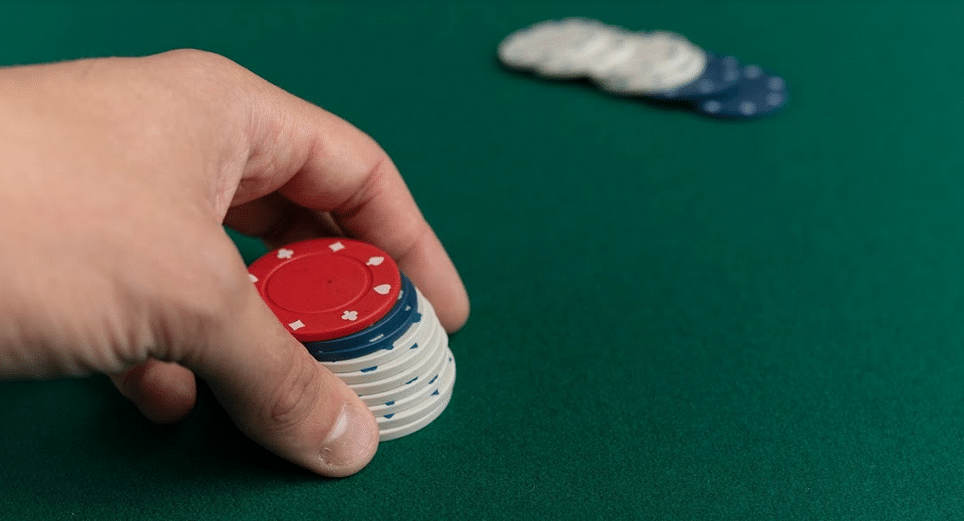Texas Holdem Minimum Raise Rules
The subject today is the min-raise — that is, somebody bets, and you submit a raise that is exactly double that amount, which is the smallest raise you can make in a no-limit game. I want to address this very specific tactic because I see it used way too much by relatively inexperienced players. I’d like to explain why it’s usually the wrong move.
Note: A min-raise is a popular preflop opening move these days in high-level tournament play, with solid game-theory math to support it. But here I’m talking about postflop play in cash games, against less sophisticated opponents, which makes it a whole different animal.
- Three times the BB is a standard raise size which we will go into later in this article under the heading “Texas Holdem betting strategy”. But first, a little more on aggression to drive home the point: You should only raise or fold your hands when first entering the pot. However, calling with some hands after someone else has raised is fine.
- Minimum raise: In No Limit Hold’em, the raise amount must be at least as much as the previous bet or raise in the same round. As an example, if the first player to act bets $5 then the second player must raise a minimum of $5 (total bet of $10).
- So at blinds of $2/$4, the minimum bet is $4 and the minimum raise would be $8 (or 2x the last bet or raise). The maximum amount a player can bet is determined by the amount in the pot. If there is $20 in the pot at a game of $2/$4 Limit Holdem, you can make a bet as large as $20.
This means that you won't be able to put in more than $6 or $8 during the first round of betting in a Texas Hold'em game with blinds at $1/$2. This rule is often put out of play when only two players remain in the hand, in which case they can continue raising until all their money is in the pot. If they want to, that is.
First, an illustrative story.
I was playing a $1/$2 game at the Golden Nugget in Las Vegas a few years ago. In early position, I had and raised to $8. Three players called. The flop was . I figured that with the nut flush draw, that flop likely helped me more than any of the others, so I bet $20. One player folded, the next min-raised to $40, and the third folded.
Let’s do some math here. The pot was now about $90, and it would cost me $20 to call, making pot odds of 4.5-to-1. Will I make my flush on the turn? Well, there are 9 hearts remaining out of the 47 unknown cards, so the probability is 9/47, or about 19%, which translates to about 4.2-to-1.

This means that even if I have no implied odds (i.e., if he won’t put in any more money if I make the flush), it is mathematically correct for me to call trying to hit. If he has a hand with which he will lose more when I complete my hand, a call is even more profitable.
I called, then I got lucky — the turn was the . I checked, planning a check-raise. (In retrospect, a lead-out bet may have been a better plan, but that’s a subject for another day.) He disappointed me by checking behind.
The river was the , which could not improve any hand with which he would have raised on that flop. I bet $55 into the $110 pot. He thought for a long time before reluctantly folding his face-up.
I think this hand perfectly illustrates the main problem of the min-raise: It almost never accomplishes whatever goal the raiser had in mind.
- It makes sense to raise in order to make other players pay more than they mathematically should for a draw to a flush or straight, but a min-raise probably won’t do that.
- You might min-raise as a bluff, but that size looks so weak that it will likely get a call from anybody whose bet was not itself a pure bluff. A player with good reading skills might reraise you with nothing, just because the min-raise looks so weak.
- Perhaps the most common reason for a raise is to build a big pot with a strong hand. Surely it’s obvious that the smallest possible raise is usually not the way to build the biggest pot.
Now let me tell you another story, this one from a low-stakes (20-cent blinds) home game I played in just a few weeks ago. The final board was , with no flush possible. A young woman bet $5, which was about the size of the pot. I’ve played with her enough to know that she loves bluffing in situations like this, where nobody will dare call unless they have a specific card — in this case, an .
I had just one pair, but when the only other player in the hand folded, I thought it was a great spot for a re-bluff. I raised all-in, about $30. She instantly called and flipped over not just an , but , for the stone-cold nuts. Oops.

In retrospect, I still think raising was correct, because she will more often be bluffing than value-betting here. What I got wrong was my bet-sizing. This is one of the rare situations where a min-raise would be perfect. If she has nothing, she will just fold, because she’s not brave enough to make an all-in re-bluff. Put another way, any raise size will win me the pot if she’s bluffing, but with a min-raise I lose the least if I’m wrong and she either calls or reraises.
I can think of a few other situations where a min-raise may be the best choice:
- You have a monster hand, know that an opponent is weak, and a minimum raise is the most you can possibly hope to squeeze out of him.
- You have an overly aggressive opponent whom you have reason to believe will read a min-raise as weak, when you actually have him crushed. Here the min-raise is a trap that you hope will induce a reraise.
- You have a lock on the hand (top full house, quads, etc.) and a whole raft of loose callers to somebody’s initial bet; a min-raise may be the best way to swell the pot by giving every single one of those callers temptation to put more chips in when they’re drawing dead.
But as you can see from that list, the spots in which a min-raise is optimal are few and far between. It’s a specialty tool — like a sand wedge in golf. It’s great to have it in your bag when you need it, but it’s a bad choice in most ordinary situations.
If you have been in the habit of using a min-raise commonly, be bold and try instead a raise of perhaps 3 to 3.5 times the bet. I suspect you’ll find that it does a better job of making you money.
Robert Woolley lives in Asheville, NC. He spent several years in Las Vegas and chronicled his life in poker on the “Poker Grump” blog.
Want to stay atop all the latest in the poker world? If so, make sure to get PokerNews updates on your social media outlets. Follow us on Twitter and find us on both Facebook and Google+!
Tags
cash game strategybet-sizingmin-raisingno-limit hold’emhome gameslive pokeronline poker
Learning how to play Texas Holdem is pretty easy. It only looks complicated because there are so many rounds of action. But other than the action preflop and at showdown, each round is the same. So once you get the general idea of the game, it’ll be easy to pick it up.
This page will explain the basics behind Texas Holdem poker, including the rules, betting, winning hands and terminology.
| If you are looking for the a US poker site that is safe and secure with great rewards, a solid deposit bonus and fast cashouts then you should check out Ignition Poker. Receive a $2000 first deposit bonus, earn cash back on every hand you play and receive a check in as little as 3 weeks. Read our Ignition Poker review for more reasons why we prefer Ignition Poker over any other poker room. |

An Example Hand of Texas Holdem – Game Play & Rules
Here is an example hand of Texas Holdem. This should give you an idea as to the rules and how the game plays.
The Blinds & Hole Cards
Before the cards are dealt the blinds are posted. The small blind posts the small blind and the big blind posts the big blind.
Once the blinds are posted the dealer deals each player two cards face down, one card at a time, starting with the small blind and working around the table clockwise. These are the players hole cards.
Preflop
After the hole cards are dealt the first betting round begins. The betting round begins with the player to the immediate left of the big blind, also known as the player under the gun. The options are to call, raise or fold.
Once that player acts the action will continue clockwise around the table. Each player will have the option to call, raise or fold. It keeps going like this until all but one player has folded, winning the pot outright, or until 2 or more players called.
When the action gets to the blinds, they will only need to call the difference between what they posted and the current bet. For example, if you’re playing $2/$4 and the current bet is $12, the small blind would only have to call $10 and the big blind $8 to see the flop.
The Flop
The flop is the first 3 community cards that players can use to make their 5 card poker hand. The dealer will usually burn one card, and then turn over 3 cards in the center of the table. After this another betting round starts.
The betting round will start with the first player to the left of the dealer button that’s still involved in the hand. The options are to check or bet (players can fold too, but checking is free).
Betting will continue clockwise until each player has acted. Depending on the action, players will have the option to check (if there is no betting), call (if someone bet), fold (if someone bet) or raise (if someone bet).
The Turn

The turn is the 4th community card. The turn will play just like the flop.
The River
The river is the 5th, and last, community card that players can use to make their hand. The river will play just like the flop and turn.
Unless all but one player folded during the betting round, once all players have acted there is a showdown to determine the winner. If there was no betting on the river then the first player to the left of the dealer button will need to flip up his or her hand. If there was betting on the river then the player who made the bets/raises (not the caller) will be the first to show. Then going clockwise around the table each player can show their hand (if they think they have the best hand) or muck (if they don’t think they have the best hand).
The player with the best 5 card poker hand, using any combination of their hole cards and community cards will win the hand and pot.
After the chips are awarded, the dealer button is moved one seat to the left. The 2 players to the left of the dealer button will post the blinds and a new hand of Texas Holdem will be dealt.
Texas Holdem Betting
The betting is usually what trips people up when learning how to play Holdem. This section will explain how Texas Holdem betting works, depending on the betting type being used.
No Limit Betting
No Limit Texas Holdem, or NLHE, is the most common form of Holdem nowadays. The betting rules for NLHE are simple:
- Raises must be at least twice that of the current bet. For example, if you wanted to make a raise in a $2/$4 game, the minimum raise would be $8. It can be $9, $15 or even $11.25 — it can be whatever you have the chips for, as long as it’s 2x the current bet.
- A player can move their entire stack “all in” at any time.
Limit Betting
Texas Holdem Minimum Raise Rules
Limit or “fixed limit” betting is a little bit more complicated. Using $2/$4 blinds as an example, here is how the betting works:
Texas Holdem Minimum Raise Rules 2020
- The blinds are half of the small and big bet. So with blinds of 2/4, the small bet would be $4 and the big bet $8.
- Preflop and on the flop the small bet is used. So each bet and raise would be $4. If one player made a bet of $4 and you wanted to raise, you’d make it 8 total. If a player after you wanted to raise, it’d be to $12 total, then $16 and so on.
- The turn and river is the same as preflop and the flop, except for that the big bet is used. So each bet would be in increments of $8.
- Most poker rooms/sites have a cap of how many raises can take place per round. It depends on where you play, but it ranges from 3 to 5. After the cap has been reached, the only options are to fold or call until another the next round.
Pot Limit Betting
Texas Holdem Minimum Raise Rules And Regulations
Pot Limit is the least common betting type used in Holdem. It’s also pretty easy to understand.
- The minimum bet must be that of the big blind. The minimum raise must be 2x the big blind. So at blinds of $2/$4, the minimum bet is $4 and the minimum raise would be $8 (or 2x the last bet or raise).
- The maximum amount a player can bet is determined by the amount in the pot. If there is $20 in the pot at a game of $2/$4 Limit Holdem, you can make a bet as large as $20. Assuming you bet $20, the player after you can wager as much as $40 ($20 from you + the $20 that was in the pot before you bet). The bigger the pot gets the more that can be wagered.
- There are no betting caps. Players can continue to raise until each player has folded or called, or until everyone is “all in.”
Texas Holdem Minimum Raise Rules Against
| Looking to find all your favorite poker games online? Head to Ignition Poker. Not only do they have excellent traffic for aspiring US poker players, but also a massive $2000 deposit bonus and lightning fast cashouts. Read our Ignition Poker review for more reasons why we prefer Ignition Poker over any other poker room. |
What Hands Win in Texas Holdem
Texas Holdem uses the standard poker rankings chart to determine the winning hand. In order of best hand to worst:
- Royal Flush
- Straight Flush
- Four of a Kind
- Full House (Boat)
- Flush
- Straight
- 3 of a Kind (Trips or Set)
- Two Pair
- Pair
- High Card
In Texas Holdem if 2 or more players have the same hand, the winner is determine by who has the highest of that hand. For example, if 2 players had a flush, one a 9 high flush and the other a J high flush, the J high flush would win.
If 2 or more players have the exact same (high) hand, then the pot is split between those players.
Texas Holdem Minimum Raise Rules 2019
Suits do not break ties in Texas Holdem. It’s not possible to have more than one suit in Texas Holdem, anyway, as there aren’t enough cards in play.
Texas Holdem Terms
Here are some commonly used terms in Texas Holdem. They should help you understand this page a little better, as well as the chit-chat that might go on while you play.
Blinds – The blinds are forced bets made before the cards are dealt. It’s “dead money,” so it encourages action.
Small Blind – The small blind is the player to the immediate left of the dealer button. This player puts in the small blind, which is usually the smaller of the two forced bets, and about half the big blind. For example, in a $2/$4 Holdem game, $2 would be the small blind.
Big Blind – The big blind is the player to the immediately left of the small blind, or two seats to the left of the dealer button. This players puts in the forced big blind before the players are dealt their cards, which is usually twice the small blind. In a $2/$4 game, the big blind would be $4.
Hole Cards – Hole cards are the cards dealt to each player.
Under the Gun – This is the term used for the player first to act (usually to the immediately left of the big blind) pre-flop.
Flop – First 3 (of 5) community cards.
Turn – Fourth community card dealt. Dealt following the betting action on the flop.
River – Fifth, and final, community card. Dealt following the betting action on the turn.
Showdown – Where one or more players show their hands to see who wins the pot. Follows the betting action on the river.
Muck – When a player throws their hand away (folds), usually without showing it.